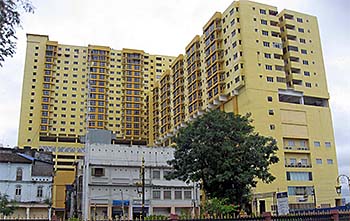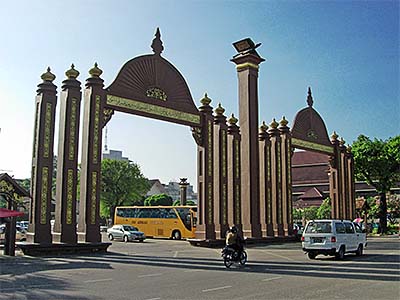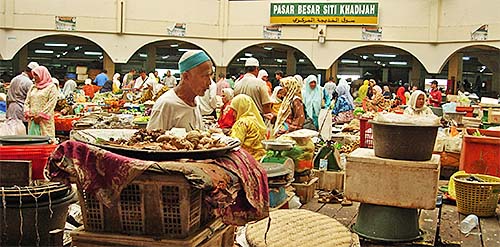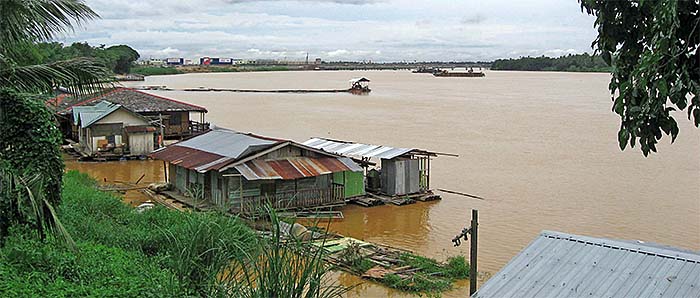Kota Bharu
The Malay place of Kota Bharu is situated closely to the seaside of east peninsular Malaysia. The city's name means 'new city' or 'new fortress'. It's not an old place, for it's foundation dates back only to the late 19th century, although some Sultan's residence buildings were placed here supposedly a few decades before.

Rapidly modernized Kota Bharu is coined by buildings like that: massive concrete. Image by Asienreisender, 9/2010
Lying in the vicinity to Thailand's deep south, Kota Bharu was rapidly developing in the years between 2005 and 2010, as I personally could witness. The change the place has been undergone in the short time span was so radical, that I didn't recognize anything anymore. I also found old maps completely outdated, and that was already in 2005. Now there must be roughly around 300.000 people living here.
Kota Bharu is the capital of the federal state of Kelantan. The area was in most of the 19th century under Siamese rule, but had to be handed over to the British colonial power in 1909. In 1941 the Japanese chose it as one of their army's landing points along the east coast of the Malay Peninsula, surprisingly attacking British forces in the Battle of Malaya (see also: 'The Battle of Prachuap Khiri Khan').

Sultan Ismail Petra Arch. Image by Asienreisender, 3/2005
The population is by 70% majoritarian Malay Muslim, while 30% are Chinese, Orang Asli (Malay natives), Tamil, Thai and others. Since the ruling party in Kota Bharu is the 'Islamic Party of Malaysia' (PAS), Islamic rules are taken very serious, following generally the pattern of the rise of Islam in Islamic countries. Once a local man who crossed my way shouted at me: "Allah is great!", what was an unneccessary reply of what is blaired out five times a day (and night) by the countless loudspeakers of the numerous mosques in town, which is officially declared an Islamic city. Morality police is around to surveil people, punishing everyone who get's caught by acting in a way not accepted by the rigid Islamic moral code applied here. Restrictions also include a conservative dressing code.
Despite the dominance of Islam, there are also Buddhist temples and maybe also a Christian minority. However, the minorities, particularly the Chinese, are here much more under assimilation pressure than along the west coast.

One of the fresh markets in the city. They are all over Southeast Asia dominated by saleswomen. Image by Asienreisender, 3/2005
Places of interest may be some of the city's museums and the old Sultan's palace, which is still in use and can be visited only outside.
The climate is very wet with much monsoonal rain, particularly in the months September to December. That is so for the whole east coast of west Malaysia.
Kota Bharu has an airport, but most of the public traffic is done by bus. Buses go along the east coast down to Johor Bahru, others to Kuala Lumpur, Malacca and Penang. There are also bus connections through Thailand's troubled south to Hat Yai. Six, seven kilometers outside of town is the next railway station which trains are connected to the Thai railway network. The line joines then Hat Yai junction. The so called 'jungle train' connects the place with Kuala Lumpur; however, the name is misleading for the tropical rainforest has long since gone and is replaced now by huge palmoil plantations. In the British past there was a railway line parallel to the east coast, but the Japanese unrigged it to use the material for the Thailand-Burma Railway (see: 'The Death Railway').

One of the wide, muddy, yellow rivers of Southeast Asia is flowing by Kota Bharu. Image by Asienreisender, 9/2010